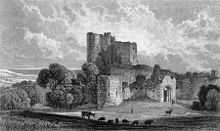Saltwood Castle

Saltwood Castle is a castle in Saltwood village—which derives its name from the castle—1 mile (2 km) north of Hythe, Kent, England.
The castle is known as the site where the plot was hatched to assassinate Thomas Becket (1118–1170). More recently, it became the home of the art historian Lord Clark of Saltwood (1903–1983), then his son Alan Clark (1928–1999), a minister in Margaret Thatcher's government.
History
Origins
The castle was probably erected on a Roman site, though Bronze Age implements and copper ingots discovered in Hayne's Wood, 1874, show the site had already long been inhabited.[1]

The castle's website traces its history back to 488 CE, when Aesc, the son of Hengist and the King of Kent, built a castle on the site.[2] It first appears, however, on a charter of King Egbert in 833. The manor of Saltwood was granted to the priory of Christ Church in Canterbury by a deed dated 1026. Under William the Conqueror, Saltwood, held by the Archbishop of Canterbury and let, under knights’ service, to Hugo de Montfort,[3] formed part of the string of large fiefs granted from Hithe to the New Forest, along the south coast of England.[4] The structure was replaced by a twelfth-century Norman structure, with work extending over the next two centuries. It became home for a period to Henry d' Essex, constable of England.[5]
Becket
Thomas Becket had asked Henry II on behalf of the Church for the restoration of the castle as an ecclesiastical palace. Henry instead gave it to one of his loyal barons named Ranulf de Bloc.[5] This leads to the implication that some complicity was possible in the murder of Becket by the baron Ranulf de Bloc.[6][7] It was during this time at Saltwood, on December 28, 1170, that four knights are presumed to have plotted the death of Becket, which took place the following day at Canterbury Cathedral, about 15 miles (24 km) away. Hugh de Moreville was one of the four knights that committed the assassination, along with Reginald Fitzurse, William de Tracey, and Richard le Breton.[5]
After Becket's assassination, the castle was returned to the control of the archbishop of Canterbury. Gun-ports in the gatehouse that date to the period 1385-94 are attributed to Henry Yevele (fl. 1353-1400), called the "English father of the science of artillery fortification" by B.H. St John O'Neil.[8] A fourteenth-century chip-carved chest with arcading and rosettes along the front, with a later panelled top, formerly in the parish church, was reputed to have come originally from Saltwood Castle.[9] The Wycliffite William Thorpe's account of his interrogation at Saltwood in 1407 is a familiar document because it was published by sixteenth-century Reformers.[10]
Recent history

Saltwood remained a church property until the reign of Henry VIII when Hythe and Saltwood were seized by the Crown. It became uninhabitable as the result of the earthquake of 6 April 1580, but was restored in the nineteenth century, as a residence once again of the Archbishop of Canterbury.[11] The gatehouse has been used as a residence ever since.[12]
During World War II, Nazi Hermann Göring ordered the Luftwaffe not to bomb Hythe, as he had designated Saltwood as his post-invasion home.[13] The castle was the childhood home of Bill Deedes and was purchased in 1955 by Kenneth Clark, whose son Alan Clark subsequently lived there. After Alan Clark's death he was buried in the castle grounds, which remains in the Clark family today.[14]
See also
References
- ↑ J. G. Waller, "Bronze Implements" The Journal of the Anthropological Institute of Great Britain and Ireland 3 (1874, pp. 230-231) p. 230.
- ↑ Clark, Alan. A Brief History of Saltwood, Saltwood Castle website, accessed April 5, 2009.
- ↑ As it was recorded in Domesday.
- ↑ H. Neilson, "Early English Woodland and Waste" The Journal of Economic History 2.1 (May 1942, pp. 54-62), p 59f suggests a consistent Norman policy in the creation of forest and building of castles nearby, where defenses could be concentrated.
- ↑ 5.0 5.1 5.2 "Local History". Saltwood Church of England Primary School. Archived from the original on 2006-07-20. Retrieved 2006-06-12.
- ↑ Shirley, Janet (1975). "Vie Saint Thomas Le Martyr De Cantobire". Garnier’s Becket. Scott Ian McLetchie. pp. 132–165. Retrieved 2006-06-12.
- ↑ "Castles Mentioned in Pillars of the Earth". Kristin's Medieval Castles of England. Retrieved 2006-06-12.
- ↑ O'Neil, Castles and Cannon: A Study of Early Artillery Fortification in England (Oford University Press) 1960 p. 21.
- ↑ Illustrated by Martin Conway, "Some Kentish Chests" The Burlington Magazine for Connoisseurs 15 No. 78 (September 1909), pp. 362-363, illustrated p. 363.
- ↑ Anne Hudson , Two Wycliffite Texts: The Sermon of William Taylor, 1406; The Testimony of William Thorpe, 1407 (Oxford University Press) 1993.
- ↑ H. D. Dale, St. Leonard's Church and the Ancient Town of Hythe 1931.
- ↑ Taylor, Charles. "Saltwood Castle". ecastles.co.uk. Retrieved 2006-06-12.
- ↑ http://www.courier.co.uk/Nazi-Hermann-Goering-dreamed-life-seaside-Hythe/story-13622005-detail/story.html
- ↑ "The Real Alan Clark". Real Lives. Channel4.com. Retrieved 2006-06-12.
External links
Coordinates: 51°4′54.64″N 1°5′3.72″E / 51.0818444°N 1.0843667°E